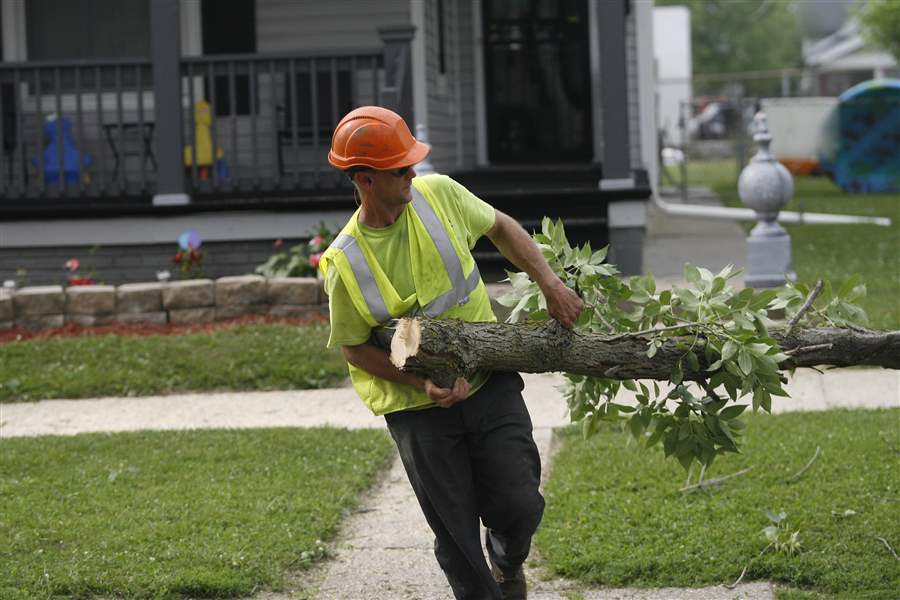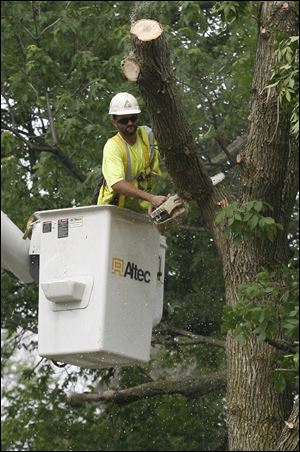
Last ash trees nearly gone
Head2
6/21/2011
Kevin England removes a branch from an ash tree. Workers from Alpine Tree Service of Newaygo, Michigan cut down ash trees on Crittenden Street on Monday.
THE BLADE/JETTA FRASER
Buy This Image

Kevin England removes a branch from an ash tree. Workers from Alpine Tree Service of Newaygo, Michigan cut down ash trees on Crittenden Street on Monday.
By the end of this year, the last ash tree will have vanished from Toledo streets.
Contractors working on Sumner Street in South Toledo have begun a final push to remove the last 1,000 of 7,700 ash trees that once lined city streets, all being eaten from the inside by the invasive emerald ash borer beetle. Toledo, the only city in Ohio to warrant a larger ash tree removal grant because of its copious ash population, has spent a total of $800,000 on ash tree removal and $207,600 on replanting. One-half of those funds came from federal grants, according to Stephanie Miller, the Ohio Department of Natural Resources' urban forester for Region 4.
Toledo plans to plant a variety of trees to replace the fallen ashes, a process forestry experts expect to repeat itself throughout the continent as the beetles -- which feed on nutrients only trees of the fraxinus genus produce -- spread in search of food.
"In our lifetime, there's not going to be any more ash trees in North America," said Toledo Forestry and Urban Beauty Commissioner Dennis Garvin.
Mr. Garvin called the infestation a public-safety threat, because large, dead tree branches can fall, potentially injuring people.
Because they are not native to North America -- emerald ash borers are believed to have arrived from Asia in wooden packing material aboard cargo ships -- creatures that might eat the beetles, such as woodpeckers, do not instinctively recognize them as food, Mr. Garvin said, although he added that some are beginning to catch on.
"Now they're hip to it," he said, "but they're on a learning curve."
Mr. Garvin said he did not think potential predators will learn fast enough to stem the infestation -- and thus, ash trees are doomed.
The beetles migrated into northwest Ohio in 2003, and since then, the city of Toledo has cut down about 1,000 ashes per year. But ash-removal campaigns in Toledo and the surrounding area, and bans on transporting firewood have failed to stem the borers' spread.
Mr. Garvin said his department is seeking to replace the ashes with a diverse group of tree species to prevent some future tree disease or insect infestation from again liquidating a large portion of the city's trees. Amy Stone, Lucas County's representative from Ohio State University Extension, added that when the state lost many of its elms trees to Dutch elm disease in the '60s, most of the trees were replaced with ash trees -- a mistake in hindsight. The emerald ash borer, she said, is an even bigger threat than the elm tree disease because ash trees do not have juvenile resistance to it and can be attacked at any age.
Because the forestry department does not want all its trees to be the same age, it will replant gradually over the next few decades, Ms. Miller said.

Drew Gifford working on an ash tree on Crittenden Street in Toledo.
"We want to make sure that when the next bug comes, the entire city won't lose so many trees again," Mr. Garvin said.
Ohio counties apply for grants from the U.S. Forest Service, which matches funds the communities put into tree removal, Ms. Miller said. In order to qualify for competitive grants up to $50,000, communities must remove all their right-of-way ash trees and replant 25 percent of the removed trees by November, she added.
Toledo suburbs removing ash trees with competitive grants include Perrysburg, Bowling Green, Genoa, Holland, Waterville, Rossford, Woodville Township, and Spencer Township, Ms. Miller said. The current Western Lake Erie Basin Emerald Ash Borer grant covers 27 counties in northwest Ohio.
The emerald ash borer flies onto a tree and lays hundreds of eggs on its branches. Larvae burrow into the tree's vascular system and eat the sugars produced during the tree's photosynthesis process. Although it may look healthy at first, the tree slowly starves to death.
Mr. Garvin said although 100 larvae in a tree would not do much damage, trees are normally infested with thousands of bugs that fly off to lay eggs on neighboring ash trees after going through metamorphosis.
Up until June 3, Ohio residents could apply to have ash trees removed by the state from their private property with up to half of the cost covered, depending on household income, Ms. Miller said. Mr. Garvin added that the city has no controlover whether private owners decide to remove the trees.
Ms. Stone said removing trees sooner will both lessen the risk of injury from large, falling pieces of the tree and cut down on removal costs. If a tree is not completely dead, tree climbers can often cut branches from above. If the tree has died, however, this task will be toodangerous, and more expensive equipment, such as cranes and bucket trucks, will be necessary to take down the ash without hurting anyone.
Ohio residents are restricted from taking the wood trees out of state to other states not already infested. Ohio is one of 16 states currently under quarantine for the pests.
Contact Zoe Gorman at: 419-724-6050 or zgorman@theblade.com